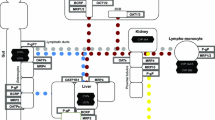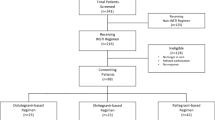Abstract
Variable antiretroviral therapy (ART) drug response likely reflects the combined influence of environment, underlying disease, concurrent drugs, and genetics. Gender exerts modest or negligible effects on ART disposition, and it is expected to have limited clinical implication, although it should be accounted for in large population studies. Ethnic denominations have, with the notable exception of efavirenz, no clear influence on ART disposition. Exploration of genetic factors might offer a better comprehension to the largely unpredictable and unresolved variability in ART concentrations and related toxicity or treatment outcome. Despite the negative perception of genetic research among the general public, this type of investigation is now widely accepted by concerned parties: patients, relatives, and study volunteers.
Similar content being viewed by others
References and Recommended Reading
Gandhi M, Aweeka F, Greenblatt RM, Blaschke TF: Sex differences in pharmacokinetics and pharmacodynamics. Annu Rev Pharmacol Toxicol 2004, 44:499–523. This review examines the biologic bases of differences in pharmacokinetics and pharmacodynamics between genders.
Brendel K, Legrand M, Taburet AM, et al.: Population pharmacokinetic analysis of indinavir in HIV-infected patient treated with a stable antiretroviral therapy. Fundam Clin Pharmacol 2005, 19:373–383.
Csajka C, Marzolini C, Fattinger K, et al.: Population pharmacokinetics of indinavir in patients infected with human immunodeficiency virus. Antimicrob Agents Chemother 2004, 48:3226–3232.
Kappelhoff BS, Huitema AD, Sankatsing SU, et al.: Population pharmacokinetics of indinavir alone and in combination with ritonavir in HIV-1-infected patients. Br J Clin Pharmacol 2005, 60:276–286.
Burger DM, Siebers MC, Hugen PWH, et al.: Pharmacokinetic variability caused by gender: do women have higher indinavir exposure than in men? J Acquir Immune Defic Syndr 2002, 29:101–102.
Ribera E, Lopez RM, Diaz M, et al.: Steady-state pharmacokinetics of a double-boosting regimen of saquinavir soft gel plus lopinavir plus minidose ritonavir in human immunodeficiency virus-infected adults. Antimicrob Agents Chemother 2004, 48:4256–4262.
Pai MP, Schriever CA, Az-Linares M, et al.: Sex-related differences in the pharmacokinetics of once-daily saquinavir soft-gelatin capsules boosted with low-dose ritonavir in patients infected with human immunodeficiency virus type 1. Pharmacotherapy 2004, 24:592–599.
Fletcher CV, Jiang H, Brundage RC, et al.: Sex-based differences in saquinavir pharmacology and virologic response in AIDS Clinical Trials Group Study 359. J Infect Dis 2004, 189:1176–1184.
Crommentuyn KM, Kappelhoff BS, Mulder JW, et al.: Population pharmacokinetics of lopinavir in combination with ritonavir in HIV-1-infected patients. Br J Clin Pharmacol 2005, 60:378–389.
Jackson KA, Rosenbaum SE, Kerr BM, et al.: A population pharmacokinetic analysis of nelfinavir mesylate in human immunodeficiency virus-infected patients enrolled in a phase III clinical trial. Antimicrob Agents Chemother 2000, 44:1832–1837.
Pfister M, Labbé L, Lu JF, et al.: Effect of coadministration of nelfinavir, indinavir and saquinavir on the pharmacokinetics of amprenavir. Clin Pharmacol Ther 2002, 72:133–141.
Csajka C, Marzolini C, Fattinger K, et al.: Population pharmacokinetics and effects of efavirenz in patients with human immunodeficiency virus infection. Clin Pharmacol Ther 2003, 73:20–30.
Pfister M, Labbe L, Hammer SM, et al.: Population pharmacokinetics and pharmacodynamics of efavirenz, nelfinavir, and indinavir: Adult AIDS Clinical Trial Group Study 398. Antimicrob Agents Chemother 2003, 47:130–137. A population pharmacokinetic and pharmacodynamic study that modeled the effect of covariates on its profile and evaluated the relationship between drug exposure and virologic failure with a particular focus on efavirenz.
Kappelhoff BS, Van LF, MacGregor TR, et al.: Nevirapine and efavirenz pharmacokinetics and covariate analysis in the 2NN study. Antivir Ther 2005, 10:145–155.
Barrett JS, Joshi AS, Chai M, et al.: Population pharmacokinetic meta-analysis with efavirenz. Int J Clin Pharmacol Ther 2002, 40:507–519.
Burger D, van der Heiden I, la Porte C, et al.: Interpatient variability in the pharmacokinetics of the HIV non-nucleoside reverse transcriptase inhibitor efavirenz: the effect of gender, race, and CYP2B6 polymorphism. Br J Clin Pharmacol 2006, 61:148–154.
Lamba V, Lamba J, Yasuda K, et al.: Hepatic CYP2B6 expression: gender and ethnic differences and relationship to CYP2B6 genotype and CAR (constitutive androstane receptor) expression. J Pharmacol Exp Ther 2003, 307:906–922.
Sabo JP, Lamson MJ, Leitz G, et al.: Pharmacokinetics of nevirapine and lamivudine in patients with HIV-1 infection. AAPS PharmSci 2000, 2:E1.
De Maat MMR, Huitema ADR, Mulder JW, et al.: Population pharmacokinetics of nevirapine in an unselected cohort of HIV-1-infected individuals. Br J Clin Pharmacol 2002, 54:378–385.
Zhou XJ, Sheiner LB, D‘Aquila RT, et al.: Population pharmacokinetics of nevirapine, zidovudine, and didanosine in human immunodeficiency virus-infected patients. The National Institute of Allergy and Infectious Diseases AIDS Clinical Trials Group Protocol 241 Investigators. Antimicrob Agents Chemother 1999, 43:121–128.
Anderson PL, Kakuda TN, Kawle S, Fletcher CV: Antiviral dynamics and sex differences of zidovudine and lamivudine triphosphate concentrations in HIV-infected individuals. AIDS 2003, 17:2159–2168.
Jullien V, Treluyer JM, Rey E, et al.: Population pharmacokinetics of tenofovir in human immunodeficiency virus-infected patients taking highly active antiretroviral therapy. Antimicrob Agents Chemother 2005, 49:3361–3366.
Mould DR, Zhang X, Nieforth K, et al.: Population pharmacokinetics and exposure-response relationship of enfuvirtide in treatment-experienced human immunodefi-ciency virus type 1-infected patients. Clin Pharmacol Ther 2005, 77:515–528.
Wilson JF, Weale ME, Smith AC, et al.: Population genetic structure of variable drug response. Nat Genet 2001, 29:265–269. A critical view and experimental data on the controversial issue of ethnicity as a phenotypic or genetic variable.
Kappelhoff BS, Huitema AD, Yalvac Z, et al.: Population pharmacokinetics of efavirenz in an unselected cohort of HIV-1-infected individuals. Clin Pharmacokinet 2005, 44:849–861.
Haas DW, Ribaudo HJ, Kim RB, et al.: Pharmacogenetics of efavirenz and central nervous system side effects: an Adult AIDS Clinical Trials Group study. AIDS 2004, 18:2391–2400. Genetic determinants of pharmacodynamics (toxicity) in the early phase of treatment.
Sadler BM, Gillotin C, Lou Y, Stein DS: In vivo effect of alpha(1)-acid glycoprotein on pharmacokinetics of amprenavir, a human immunodeficiency virus protease inhibitor. Antimicrob Agents Chemother 2001, 45:852–856.
Johnson JA, Livingston TN: Differences between blacks and whites in plasma protein binding of drugs. Eur J Clin Pharmacol 1997, 51:485–488.
Zhou HH, Adedoyin A, Wilkinson GR: Differences in plasma binding of drugs between Caucasians and Chinese subjects. Clin Pharmacol Ther 1990, 48:10 -17.
Ioannidis JP, Ntzani EE, Trikalinos TA: ‘Racial’ differences in genetic effects for complex diseases. Nat Genet 2004, 36:1312–1318.
Fellay J, Marzolini C, Meaden ER, et al.: Response to antiretroviral treatment in HIV-1-infected individuals with allelic variants of the multidrug resistance transporter 1: a pharmacogenetics study. Lancet 2002, 359:30–36. First comprehensive pharmacogenetics study in the field of antiretroviral therapy.
Haas DW, Smeaton LM, Shafer RW, et al.: Pharmacogenetics of long-term responses to antiretroviral regimens containing efavirenz and/or nelfinavir: an Adult AIDS Clinical Trials Group Study. J Infect Dis 2005, 192:1931–1942. Genetic determinants of pharmacodynamics (antiviral efficacy) in a clinical trial.
Frohlich M, Hoffmann MM, Burhenne J, et al.: Association of the CYP3A5 A6986G (CYP3A5³) polymorphism with saquinavir pharmacokinetics. Br J Clin Pharmacol 2004, 58:443–444.
Mouly SJ, Matheny C, Paine MF, et al.: Variation in oral clearance of saquinavir is predicted by CYP3A5¹ genotype but not by enterocyte content of cytochrome P450 3A5. Clin Pharmacol Ther 2005, 78:605–618.
Eap CB, Buclin T, Cucchia G, et al.: Oral administration of a low dose of midazolam (75 microg) as an in vivo probe for CYP3A activity. Eur J Clin Pharmacol 2004, 60:237–246.
Wedlund PJ: The CYP2C19 enzyme polymorphism. Pharmacology 2000, 61:174 -183.
Rodriguez-Novoa S, Barreiro P, Rendon A, et al.: Influence of 516G>T polymorphisms at the gene encoding the CYP450-2B6 isoenzyme on efavirenz plasma concentrations in HIV-infected subjects. Clin Infect Dis 2005, 40:1358–1361.
Rotger M, Colombo S, Furrer H, et al.: Influence of CYP2B6 polymorphism on plasma and intracellular concentrations and toxicity of efavirenz and nevirapine in HIV-infected patients. Pharmacogenet Genomics 2005, 15:1–5. etic determinants of pharmacodynamics (toxicity) in the chronic phase of treatment.
Tsuchiya K, Gatanaga H, Tachikawa N, et al.: Homozygous CYP2B6 *6 (Q172H and K262R) correlates with high plasma efavirenz concentrations in HIV-1 patients treated with standard efavirenz-containing regimens. Biochem Biophys Res Commun 2004, 319:1322–1326. First study showing the association between CYP2B6 516G>T and high efavirenz plasma levels.
Klein K, Lang T, Saussele T, et al.: Genetic variability of CYP2B6 in populations of African and Asian origin: allele frequencies, novel functional variants, and possible implications for anti-HIV therapy with efavirenz. Pharmacogenet Genomics 2005, 15:861–873. Comprehensive analysis of CYP2B6 diversity.
Wang J, Sonnerborg A, Rane A, et al.: Identification of a novel specific CYP2B6 allele in Africans causing impaired metabolism of the HIV drug efavirenz. Pharmacogenet Genomics 2006, 16:191–198.
Rotger M, Colombo S, Cavassini M, et al.: Genetic variability of CYP2B6 in individuals with extremely high efavirenz plasma concentrations [abstract]. Paper presented at the 13th Conference of Retroviruses and Opportunistic Infections. Denver, CO; February 5–8, 2006.
Hoffmeyer S, Burk O, von Richter O, et al.: Functional polymorphisms of the human multidrug-resistance gene: multiple sequence variations and correlation of one allele with P-glycoprotein expression and activity in vivo. Proc Natl Acad Sci U S A 2000, 97:3473–3478.
Wang D, Johnson AD, Papp AC, et al.: Multidrug resistance polypeptide 1 (MDR1, ABCB1) variant 3435C>T affects mRNA stability. Pharmacogenet Genomics 2005, 15:693–704.
Schaeffeler E, Eichelbaum M, Brinkmann U, et al.: Frequency of C3435T polymorphism of MDR1 gene in African people. Lancet 2001, 358:383–384.
Colombo S, Soranzo N, Rotger M, et al.: Influence of ABCB1, ABCC1, ABCC2, and ABCG2 haplotypes on the cellular exposure of nelfinavir in vivo. Pharmacogenet Genomics 2005, 15:599–608. Haplotypic analysis is not superior to single SNPs analysis for predicting nelfinavir intracellular levels.
Lee-Tauber B, Decosterd L, Kerb R, Telenti A: Pharmacogenetics in infectious. In Principles of Clinical Pharmacogenomics and Introduction to Pharmaco Proteomics. Edited by Wong SHY, Linder M, and Valdes R Jr. Abingdon: Taylor and Francis Books; 2006:155.
Saito S, Iida A, Sekine A, et al.: Identification of 779 genetic variations in eight genes encoding members of the ATP-binding cassette, subfamily C (ABCC/MRP/CFTR. J Hum Genet 2002, 47:147–171.
Chang TK, Bandiera SM, Chen J: Constitutive androstane receptor and pregnane X receptor gene expression in human liver: interindividual variability and correlation with CYP2B6 mRNA levels. Drug Metab Dispos 2003, 31:7–10.
Ikeda S, Kurose K, Ozawa S, et al.: Twenty-six novel single nucleotide polymorphisms and their frequencies of the NR1I3 (CAR) gene in a Japanese population. Drug Metab Pharmacokinet 2003, 18:413–418.
Zhang J, Kuehl P, Green ED, et al.: The human pregnane X receptor: genomic structure and Identification and functional characterization of natural allelic variants. Pharmacogenetics 2001, 11:555–572.
Colombo S, Buclin T, Decosterd L, et al.: Orosomucoid plasma concentration and genetic variants: effects on HIV protease inhibitor clearance and cellular accumulation [abstract]. Paper presented at the 7th International Workshop on Clinical Pharmacology of HIV Therapy. Lisbon; April 20–22, 2006.
Marzolini C, Kim RB, Telenti A: Pharmacogenetics of antiretroviral agnets. In AIDS Therapy. Edited by Dolin R, Masur H, and Saag MS. Oxford: Churchill Livingston; 2006.
Haas DW, Wilkinson GR, Kuritzkes DR, et al.: A multiinvestigator/ institutional DNA bank for AIDS-related human genetic studies: AACTG Protocol A5128. HIV Clin Trials 2003, 4:287–300. A model initiative for integration of genetics in clinical research in drug trials.
Chen DT, Rosenstein DL, Muthappan P, et al.: Research with stored biological samples: what do research participants want? Arch Intern Med 2005, 165:652–655. A detailed description of the attitude of patients and healthy volunteers towards genetic research. Despite the common belief most participants are willing to provide permission to facilitate long-term use of their samples.
Author information
Authors and Affiliations
Corresponding author
Rights and permissions
About this article
Cite this article
Rotger, M., Csajka, C. & Telenti, A. Genetic, ethnic, and gender differences in the pharmacokinetics of antiretroviral agents. Curr HIV/AIDS Rep 3, 118–125 (2006). https://doi.org/10.1007/BF02696655
Issue Date:
DOI: https://doi.org/10.1007/BF02696655




